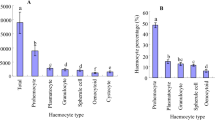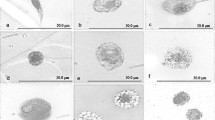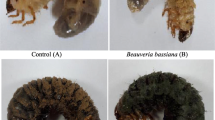Abstract
The in vivo development of the entomogenous hyphomycetePaecilomyces farinosus inSpodoptera exigua (beet armyworm) larvae was examined using light and electron microscopic techniques. Blastospores injected into larval hemocoels (500 blastospores/larva) were immediately ingested by phagocytic hemocytes, and no fungal cells were detected in the hemolymph until ∼36 h post-injection. As indicated by immunocytochemical methods, the in vivo-produced blastosopres, in contrast to in vitro blastospores, lacked a galacto-mannan surface layer required for opsonization by aS. exigua humoral lectin. Therefore, these in vivo cells were not recognized by phagocytic granulocytes and were freely-circulating in the hemolymph. Hyphae differentiating from the blastospores were recognized by the hemocytes and induced formation of multicellular hemocytic nodules. By 72 h post-injection, mycelia were observed emerging from the nodules and by 96 h, larvae had become mummified due to extensive proliferation of the fungus throughout host tissues. Neither phagocytosis of the initially injected in vitro-produced blastospores nor nodule formation around hyphal cells later in the infection process was effective in stopping fungal growth. The in vivo development ofP. farinosus was similar to that of another hyphomycete,Beauveria bassiana except that in the latter case, extensive nodule formation was inhibited by the production of fungal metabolites.
Similar content being viewed by others
References
Brawner DL, Cutler JE. Variability in expression of cell surface antigens ofCandida albicans during morphogenesis. Infect Immun 1986; 51: 337–43.
Molinari A, Gomez MJ, Crateri P, Torosantucci A, Cassone A, Arancia G. Differential cell surface expression of mannoprotein epitopes in yeast and mycelial forms ofCandida albicans. Eur J Cell Biol 1993; 60: 146–53.
Ponton J, Marot-Leblond A, Ezkurra P A, Barturen B, Robert R, Marcel-Senet J. Characterization ofCandida albicans cell wall antigens with monoclonal antibodies. Infect Immun 1993; 61: 4842–7.
Brawner DL, Cutler JE. Ultrastructural and biochemical studies of two dynamically expressed cell surface determinants onCandida albicans. Infect Immun 1986; 51: 327–36.
Odds FC.Candida species and virulence. ASM News 1994; 60: 313–8.
Calderone RA, Braun PC. Adherence and receptor relationships ofCandida albicans. Microbiol Rev 1991; 55: 1–20.
Pendland JC, Boucias DG. Variations in the ability of galactose and mannose-specific lectins to bind to cell wall surfaces during growth of the insect pathogenic fungusPaecilomyces farinosus. Eur J Cell Biol 1993; 60: 322–30.
Pendland JC, Heath MA, Boucias DG. Function of a galactose-binding lectin fromSpodoptera exigua larval haemolymph: opsonization of blastospores from entomogenous hyphomycetes. J Insect Physiol 1988; 34: 533–40.
Pendland JC, Hung S-Y, Boucias DG. Evasion of host defense by in vivo produced protoplast-like cells of the insect mycopathogenBeauveria bassiana. J Bacteriol 1993; 175: 5962–9.
Hung S-Y, Boucias DG. Influence ofBeauveria bassiana on the cellular defense response of the beet armyworm,Spodoptera exigua. J Invertebr Pathol 1992; 60: 152–8.
Hung S-Y, Boucias DG, Vey AJ. Effect ofBeauveria bassiana andCandida albicans on the cellular defense response ofSpodotera exigua. J Invertebr Pathol 1993; 61: 179–87.
Greene GL, Leppla NC, Dickerson WA. Velvetbean caterpillar: a rearing procedure and artificial medium. J Econ Entomol 1976; 69: 487–8.
Pendland JC, Boucias DG. Characteristics of a galactose-binding hemagglutinin (lectin) from hemolymph ofSpodoptera exigua larvae. Dev Comp Immunol 1986; 10: 477–87.
Boucias DG, Pendland JC. The galactose-binding lectin from the beet armyworm,Spodoptera exigua: distribution and site of synthesis. Insect Biochem Molec Biol 1993; 23: 233–42.
Small PLC, Ramakrishnan L, Falkow S. Remodeling schemes of intracellular pathogens. Science 1994; 263: 637–9.
David L, Weiser J. Role of hemocytes in the propagation of a microsporidian infection in larvae ofGalleria mellonella. J Invertebr Pathol 1994; 63: 212–3.
Ratcliffe NA, Rowley AF. Role of hemocytes in defense against biological agents. In: Gupta AP, ed. Insect Hemocytes. New York: Cambridge University Press, 1979: 333–414.
Boucias DG, Pendland JC. The fungal cell wall and its involvement in the pathogenic process in insect hosts. In: Latge J-P, Boucias DG, eds. Fungal Cell Wall and Immune Response. Berlin: Springer-Verlag, 1991: 303–16.
Mazet I, Pendland JC, Boucias DG. Comparative analysis of phagocytosis of fungal cells by insect hemocytes versus horse neutrophils. Dev Comp Immunol 1994; 18: 455–66.
LoVelle B, Beaman BL. The role of oxygen and its derivatives in microbial pathogenesis and host defense. Ann Rev Microbiol 1984; 38: 27–48.
Ahmad S, Duval DL, Weinhold LC, Pardini RS. Cabbage looper antioxidant enzymes: tissue specificity. Insect Biochem 1991; 21: 563–72.
Newman SL, Gootee L, Morris R, Bullock WE. Digestion ofHistolasma capsulation yeasts by human macrophages. J Immunol 1992; 149: 574–80.
Author information
Authors and Affiliations
Rights and permissions
About this article
Cite this article
Pendland, J.C., Hung, SY. & Boucias, D. In vivo development of the entomogeneous hyphomycetePaecilomyces farinosus in hostSpodoptera exigua (beet armyworm) larvae. Mycopathologia 130, 151–158 (1995). https://doi.org/10.1007/BF01103098
Received:
Accepted:
Issue Date:
DOI: https://doi.org/10.1007/BF01103098




